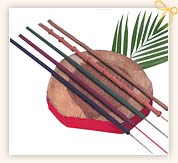Incense Sticks
 No religious occasion can be completed without the
use of incense sticks which provide an aura of purity by its
fragrance. Let us know more about incense under the following
No religious occasion can be completed without the
use of incense sticks which provide an aura of purity by its
fragrance. Let us know more about incense under the following
Types of Incense
Ingredients of Incense
Since Vedic times, fragrance has always been a dominant factor in Hindu religious rituals. There are thousands of incenses made in India, which are available in all shapes and sizes. There are cone shaped incenses, gummy log types, powders, raw woods, resins, wood chips, pastes, and even liquids or oils.
Ingredients of incense can be classified into the following categories on the basis of five elements and their Ayurvedic relationship to plants. The relationship is shown below :
- Earth (Roots) : Turmeric, Ginger, Costus Root, Valerian, Spikenard etc.
- Fire (flower) : Clove
- Air (leaves) : Patchouli
- Ether (Fruits) : Star Anise
- Water (Stems and Branches) : Sandalwood, Aloeswood, Cedarwood, Cassia, Myrrh, Borneol etc.
Incense General Information
 Incense is a kind of "mental stimulant" which are
made by extracting the perfume of sacred wood and flowers and its
aim is to make the atmosphere congenial for spiritual contemplation.
Incense is available in India in two forms:
Incense is a kind of "mental stimulant" which are
made by extracting the perfume of sacred wood and flowers and its
aim is to make the atmosphere congenial for spiritual contemplation.
Incense is available in India in two forms:
- Dhoop
- Agarbatti
Dhoop Incense
Dhoop is a special kind of incense which is burned in temples or a
worship room. The ingredients of incense are made into a paste or
dough and formed into rolls, also called "pastels" or "logs" without
a stick. Sometimes the dhoop is hard and dried while at other times
it is soft and malleable. This kind of incense is extremely
fragrant. The term dhoop actually originates from the dhoop tree
which is found in eastern India-whose chips give out a rich
fragrance when burnt. But the popularly used dhoop is the
black-colored putty which is essentially a mixture of ghee, herbs
and wood chips. Dhoop, in effect, is a miniature form of havan.
Agarbatti/Incense Sticks
The most popular style of incense in India is in stick form called "Agarbatti".
In India, an incense stick is an integral part of every religion.
Among the numerous varieties of incense sticks, there are many
ancient formulations which which have passed down the skills of
incense making for generations. In fact, incense sticks have become
a part of our daily rituals. Incense smoke permeates almost every
place of worship in the country or for that matter the whole
world-crowded temples, places of Vedic fire worship, echoing
churches, smoke-filled monasteries, mosques etc.
There are thousands of fragrances with which incense sticks are made
and usually each fragrance has a specific effect. It is often
recommended that jasmine or lavender fragrant incenses are the best
for calming the mind and providing relief from stress. While this
may be true in several cases, each individual has a unique mind-set.
It is better to choose the fragrance that has a pleasing and
peaceful effect upon you. Efforts to categorize fragrances of
incenses to definite emotions are at best subjective.
